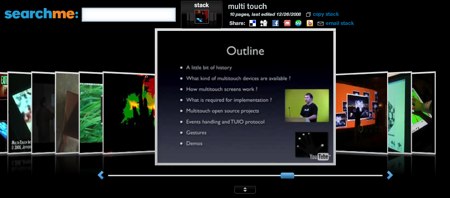 |
|
|
In a December 23 article, Technology Review writer, Kate Greene described three technologies that have received special attention this past year. The first, I find interesting today, because of mention that Greene makes of a do-it-yourself (DIY) spirit that has emerged around it. Most of us were introduced to multitouch through our iPhones. But the real potentials were illustrated by Microsoft’s Surface device, and the slew of videos that popped up on YouTube demonstrating the technology. Here is a SearchMe stack of other MT videos.
There’s little that is really new about multitouch technology, except that it has become cheaper. Nordt, a research studio (I like that term) in New York, now offers a product called TouchKit. With this $1,000 kit, anyone can make and modify their own touch-screen table. In a referenced article, Greene writes about Addie Wagenknecht [Eyebeam Profile, Wikipedia Article] and Eyebeam’s project called Cubit. She and Stefan Hechenberger wanted to illustrate how anyone could build a multitouch table with a few simple items — for $500 to $1,000. Here is a video demo of Cubit.
 |
|
|
Computer memory has also taken some interesting twists during the past year, especially with the appearance of the “popping up all over technology conferences” netbooks, many of which utilize flash memory for long term storage, rather than hard disks. Greene talks about some advances that were talked about this year, and will likely starter emerging as early as 2009. The first was phase-change memory, “..which stores data by altering the crystal structure of a material (rather than using the charge within transistors)..” Samsung and Swiss startup, Numonyx, have already started sending test samples to gadget makers.
It seems that information devices might be getting even smaller. Makes my head hurt!
Microprocessors are also seeing advances, partly stemming from our new love affair with anything green. The most notable development is Intel’s Atom processor, a low energing chip that is appear in small notebook (netbook) computers and some handhelds.
But to take things even smaller, researchers at the university of Michigan have designed a chip for small sensor applications. It uses 30 picowatts (one million millionths [10-12] of a watt) (( “Picowatt.” Wictionary. 2006.Wikimedia. 29 Dec 2008 <http://en.wiktionary.org/w/index.php?title=picowatt&oldid=1917664>.)) of power while idling, and only 2.8 picojoules (one million millionths [10-12] of a joule) (( “Picojoule.” Wiktionary. 2007. Wikimedia. 29 Dec 2008 <http://en.wiktionary.org/w/index.php?title=picojoule&oldid=4539693>.)) per computing cycle. Probably means no more to you than it does to me. But the thing could be powered by a battery no bigger than it is.
Read more about wireless advances, and mobile mania at The Year in Computing from Technology Review.
Powered by ScribeFire.

Amazing what is being done nowadays with technology!
http://debrennersmith.blogspot.com/
It is amazing what is being developed. I keep thinking I will buy a new laptop, no I will wait. I am going to have to bite the bullet and just go for it soon.
Special Reports 10 Emerging Technologies 2008
Modeling Surprise
Combining massive quantities of data, insights into human psychology, and machine learning can help manage surprising events, says Eric Horvitz.
Probabilistic Chips
Krishna Palem thinks a little uncertainty in chips could extend battery life in mobile devices–and maybe the duration of Moore’s Law, too.
NanoRadio
Alex Zettl’s tiny radios, built from nanotubes, could improve everything from cell phones to medical diagnostics.
Wireless Power
Physicist Marin Soljacic is working toward a world of wireless electricity.
Atomic Magnetometers
John Kitching’s tiny magnetic-field sensors will take MRI where it’s never gone before.
Offline Web Applications
Adobe’s Kevin Lynch believes that computing applications will become more powerful when they take advantage of the browser and the desktop.
Graphene Transistors
A new form of carbon being pioneered by Walter de Heer of Georgia Tech could lead to speedy, compact computer processors.
Connectomics
Jeff Lichtman hopes to elucidate brain development and disease with new technologies that illuminate the web of neural circuits.
Reality Mining
Sandy Pentland is using data gathered by cell phones to learn about human behavior.
Cellulolytic Enzymes
Frances Arnold is designing better enzymes for making biofuels from cellulose.
just a correction… Your explanation of picowatt should read as the explanation for picojoule: one million millionths of a watt.
Breath-takingly small numbers nonetheless.
Its true when i look to my phone! and i see that it have a best processor than my old computer!
Technology 2008 is history by now. Technology is evolving so quick that we human has to make more effort in actually cope with it.
Barbara and the team at V London writes about Men’s Health and Issues in London, Fashion and Women, Technology and World.
People seem to have lost interest tracking the development of the IT technologies and the increasing computing power of processors, while latter seem to have long ago advanced to the levels a layer man really does not need.